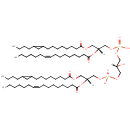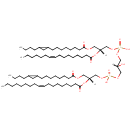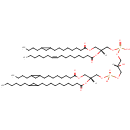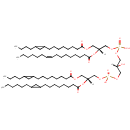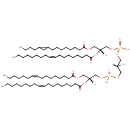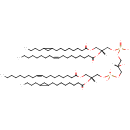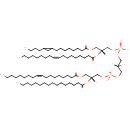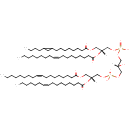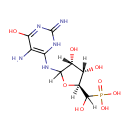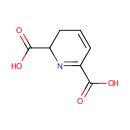
Search Results for compounds
Searching compounds for
returned 4373 results.
CL(15:0cyclo/16:1(9Z)/15:0cyclo/16:1(9Z)) (PAMDB002154)
IUPAC:
[(2R)-3-{[8-(2-butylcyclopropyl)octanoyl]oxy}-2-[(9Z)-hexadec-9-enoyloxy]propoxy][3-({[(2R)-3-{[8-(2-butylcyclopropyl)octanoyl]oxy}-2-[(9Z)-hexadec-9-enoyloxy]propoxy](hydroxy)phosphoryl}oxy)-2-hydroxypropoxy]phosphinic acid
CAS: Not Available
Description: CL(15:0cyclo/16:1(9Z)/15:0cyclo/16:1(9Z)) is a cardiolipin (CL). Cardiolipins are sometimes called a 'double' phospholipid because they have four fatty acid tails, instead of the usual two. CL(15:0cyclo/16:1(9Z)/15:0cyclo/16:1(9Z)) contains two chains of cis-9,10-Methylenetetradecanoic acid at the C1 and C3 positions, two chains of (9Z-hexadecenoyl) at the C2 and C4 positions. While the theoretical charge of cardiolipins is -2, under normal physiological conditions (pH near 7), the molecule may carry only one negative charge. In prokaryotes such as Pseudomonas aeruginosa, the enzyme known as diphosphatidylglycerol synthase catalyses the transfer of the phosphatidyl moiety of one phosphatidylglycerol to the free 3'-hydroxyl group of another, with the elimination of one molecule of glycerol. In Pseudomonas aeruginosa, which acylates its glycerophospholipids with acyl chains ranging in length from 12 to 19 carbons and possibly containing an unsaturation, or a cyclopropane group more than 100 possible CL molecular species are theoretically possible. Pseudomonas aeruginosa membranes consist of ~5% cardiolipin (CL), 20-25% phosphatidylglycerol (PG), and 70-80% phosphatidylethanolamine (PE) as well as smaller amounts of phosphatidylserine (PS). CL is distributed between the two leaflets of the bilayers and is located preferentially at the poles and septa in Pseudomonas aeruginosa and other rod-shaped bacteria. It is known that the polar positioning of the proline transporter ProP and the mechanosensitive ion channel MscS in Pseudomonas aeruginosa is dependent on CL. It is believed that cell shape may influence the localization of CL and the localization of certain membrane proteins.
CL(15:0cyclo/16:1(9Z)/15:0cyclo/18:1(9Z)) (PAMDB002155)
IUPAC:
[(2R)-3-{[8-(2-butylcyclopropyl)octanoyl]oxy}-2-[(9Z)-hexadec-9-enoyloxy]propoxy][(2S)-3-({[(2R)-3-{[8-(2-butylcyclopropyl)octanoyl]oxy}-2-[(9Z)-octadec-9-enoyloxy]propoxy](hydroxy)phosphoryl}oxy)-2-hydroxypropoxy]phosphinic acid
CAS: Not Available
Description: CL(15:0cyclo/16:1(9Z)/15:0cyclo/18:1(9Z)) is a cardiolipin (CL). Cardiolipins are sometimes called a 'double' phospholipid because they have four fatty acid tails, instead of the usual two. CL(15:0cyclo/16:1(9Z)/15:0cyclo/18:1(9Z)) contains two chains of cis-9,10-Methylenetetradecanoic acid at the C1 and C3 positions, one chain of (9Z-hexadecenoyl) at the C2 position, one chain of (9Z-octadecenoyl) at the C4 position. While the theoretical charge of cardiolipins is -2, under normal physiological conditions (pH near 7), the molecule may carry only one negative charge. In prokaryotes such as Pseudomonas aeruginosa, the enzyme known as diphosphatidylglycerol synthase catalyses the transfer of the phosphatidyl moiety of one phosphatidylglycerol to the free 3'-hydroxyl group of another, with the elimination of one molecule of glycerol. In Pseudomonas aeruginosa, which acylates its glycerophospholipids with acyl chains ranging in length from 12 to 19 carbons and possibly containing an unsaturation, or a cyclopropane group more than 100 possible CL molecular species are theoretically possible. Pseudomonas aeruginosa membranes consist of ~5% cardiolipin (CL), 20-25% phosphatidylglycerol (PG), and 70-80% phosphatidylethanolamine (PE) as well as smaller amounts of phosphatidylserine (PS). CL is distributed between the two leaflets of the bilayers and is located preferentially at the poles and septa in Pseudomonas aeruginosa and other rod-shaped bacteria. It is known that the polar positioning of the proline transporter ProP and the mechanosensitive ion channel MscS in Pseudomonas aeruginosa is dependent on CL. It is believed that cell shape may influence the localization of CL and the localization of certain membrane proteins.
CL(15:0cyclo/16:1(9Z)/15:0cyclo/19:0cycv8c) (PAMDB002156)
IUPAC:
[(2R)-3-({[(2R)-3-{[8-(2-butylcyclopropyl)octanoyl]oxy}-2-[(9Z)-hexadec-9-enoyloxy]propoxy](hydroxy)phosphoryl}oxy)-2-hydroxypropoxy][(2R)-3-{[8-(2-butylcyclopropyl)octanoyl]oxy}-2-{[10-(2-hexylcyclopropyl)decanoyl]oxy}propoxy]phosphinic acid
CAS: Not Available
Description: CL(15:0cyclo/16:1(9Z)/15:0cyclo/19:0cycv8c) is a cardiolipin (CL). Cardiolipins are sometimes called a 'double' phospholipid because they have four fatty acid tails, instead of the usual two. CL(15:0cyclo/16:1(9Z)/15:0cyclo/19:0cycv8c) contains two chains of cis-9,10-Methylenetetradecanoic acid at the C1 and C3 positions, one chain of (9Z-hexadecenoyl) at the C2 position, one chain of (heptadec-11-12-cyclo-anoyl) at the C4 position. While the theoretical charge of cardiolipins is -2, under normal physiological conditions (pH near 7), the molecule may carry only one negative charge. In prokaryotes such as Pseudomonas aeruginosa, the enzyme known as diphosphatidylglycerol synthase catalyses the transfer of the phosphatidyl moiety of one phosphatidylglycerol to the free 3'-hydroxyl group of another, with the elimination of one molecule of glycerol. In Pseudomonas aeruginosa, which acylates its glycerophospholipids with acyl chains ranging in length from 12 to 19 carbons and possibly containing an unsaturation, or a cyclopropane group more than 100 possible CL molecular species are theoretically possible. Pseudomonas aeruginosa membranes consist of ~5% cardiolipin (CL), 20-25% phosphatidylglycerol (PG), and 70-80% phosphatidylethanolamine (PE) as well as smaller amounts of phosphatidylserine (PS). CL is distributed between the two leaflets of the bilayers and is located preferentially at the poles and septa in Pseudomonas aeruginosa and other rod-shaped bacteria. It is known that the polar positioning of the proline transporter ProP and the mechanosensitive ion channel MscS in Pseudomonas aeruginosa is dependent on CL. It is believed that cell shape may influence the localization of CL and the localization of certain membrane proteins.
CL(15:0cyclo/16:1(9Z)/15:0cyclo/17:0cycw7c) (PAMDB002157)
IUPAC:
[(2S)-3-({[(2R)-3-{[8-(2-butylcyclopropyl)octanoyl]oxy}-2-[(9Z)-hexadec-9-enoyloxy]propoxy](hydroxy)phosphoryl}oxy)-2-hydroxypropoxy][(2R)-3-{[8-(2-butylcyclopropyl)octanoyl]oxy}-2-{[8-(2-hexylcyclopropyl)octanoyl]oxy}propoxy]phosphinic acid
CAS: Not Available
Description: CL(15:0cyclo/16:1(9Z)/15:0cyclo/17:0cycw7c) is a cardiolipin (CL). Cardiolipins are sometimes called a 'double' phospholipid because they have four fatty acid tails, instead of the usual two. CL(15:0cyclo/16:1(9Z)/15:0cyclo/17:0cycw7c) contains two chains of cis-9,10-Methylenetetradecanoic acid at the C1 and C3 positions, one chain of (9Z-hexadecenoyl) at the C2 position, one chain of (heptadec-9-10-cyclo-anoyl) at the C4 position. While the theoretical charge of cardiolipins is -2, under normal physiological conditions (pH near 7), the molecule may carry only one negative charge. In prokaryotes such as Pseudomonas aeruginosa, the enzyme known as diphosphatidylglycerol synthase catalyses the transfer of the phosphatidyl moiety of one phosphatidylglycerol to the free 3'-hydroxyl group of another, with the elimination of one molecule of glycerol. In Pseudomonas aeruginosa, which acylates its glycerophospholipids with acyl chains ranging in length from 12 to 19 carbons and possibly containing an unsaturation, or a cyclopropane group more than 100 possible CL molecular species are theoretically possible. Pseudomonas aeruginosa membranes consist of ~5% cardiolipin (CL), 20-25% phosphatidylglycerol (PG), and 70-80% phosphatidylethanolamine (PE) as well as smaller amounts of phosphatidylserine (PS). CL is distributed between the two leaflets of the bilayers and is located preferentially at the poles and septa in Pseudomonas aeruginosa and other rod-shaped bacteria. It is known that the polar positioning of the proline transporter ProP and the mechanosensitive ion channel MscS in Pseudomonas aeruginosa is dependent on CL. It is believed that cell shape may influence the localization of CL and the localization of certain membrane proteins.
CL(15:0cyclo/18:1(9Z)/16:1(9Z)/18:1(9Z)) (PAMDB002214)
IUPAC:
[(2R)-3-{[8-(2-butylcyclopropyl)octanoyl]oxy}-2-[(9Z)-octadec-9-enoyloxy]propoxy][(2R)-3-({[(2R)-3-[(9Z)-hexadec-9-enoyloxy]-2-[(9Z)-octadec-9-enoyloxy]propoxy](hydroxy)phosphoryl}oxy)-2-hydroxypropoxy]phosphinic acid
CAS: Not Available
Description: CL(15:0cyclo/18:1(9Z)/16:1(9Z)/18:1(9Z)) is a cardiolipin (CL). Cardiolipins are sometimes called a 'double' phospholipid because they have four fatty acid tails, instead of the usual two. CL(15:0cyclo/18:1(9Z)/16:1(9Z)/18:1(9Z)) contains one chain of cis-9,10-Methylenetetradecanoic acid at the C1 position, two chains of (9Z-octadecenoyl) at the C2 and C4 positions, one chain of (9Z-hexadecenoyl) at the C3 position. While the theoretical charge of cardiolipins is -2, under normal physiological conditions (pH near 7), the molecule may carry only one negative charge. In prokaryotes such as Pseudomonas aeruginosa, the enzyme known as diphosphatidylglycerol synthase catalyses the transfer of the phosphatidyl moiety of one phosphatidylglycerol to the free 3'-hydroxyl group of another, with the elimination of one molecule of glycerol. In Pseudomonas aeruginosa, which acylates its glycerophospholipids with acyl chains ranging in length from 12 to 19 carbons and possibly containing an unsaturation, or a cyclopropane group more than 100 possible CL molecular species are theoretically possible. Pseudomonas aeruginosa membranes consist of ~5% cardiolipin (CL), 20-25% phosphatidylglycerol (PG), and 70-80% phosphatidylethanolamine (PE) as well as smaller amounts of phosphatidylserine (PS). CL is distributed between the two leaflets of the bilayers and is located preferentially at the poles and septa in Pseudomonas aeruginosa and other rod-shaped bacteria. It is known that the polar positioning of the proline transporter ProP and the mechanosensitive ion channel MscS in Pseudomonas aeruginosa is dependent on CL. It is believed that cell shape may influence the localization of CL and the localization of certain membrane proteins.
CL(15:0cyclo/18:1(9Z)/18:1(9Z)/15:0cyclo) (PAMDB002218)
IUPAC:
[(2S)-3-({[(2R)-3-{[8-(2-butylcyclopropyl)octanoyl]oxy}-2-[(9Z)-octadec-9-enoyloxy]propoxy](hydroxy)phosphoryl}oxy)-2-hydroxypropoxy][(2R)-2-{[8-(2-butylcyclopropyl)octanoyl]oxy}-3-[(9Z)-octadec-9-enoyloxy]propoxy]phosphinic acid
CAS: Not Available
Description: CL(15:0cyclo/18:1(9Z)/18:1(9Z)/15:0cyclo) is a cardiolipin (CL). Cardiolipins are sometimes called a 'double' phospholipid because they have four fatty acid tails, instead of the usual two. CL(15:0cyclo/18:1(9Z)/18:1(9Z)/15:0cyclo) contains two chains of cis-9,10-Methylenetetradecanoic acid at the C1 and C4 positions, two chains of (9Z-octadecenoyl) at the C2 and C3 positions. While the theoretical charge of cardiolipins is -2, under normal physiological conditions (pH near 7), the molecule may carry only one negative charge. In prokaryotes such as Pseudomonas aeruginosa, the enzyme known as diphosphatidylglycerol synthase catalyses the transfer of the phosphatidyl moiety of one phosphatidylglycerol to the free 3'-hydroxyl group of another, with the elimination of one molecule of glycerol. In Pseudomonas aeruginosa, which acylates its glycerophospholipids with acyl chains ranging in length from 12 to 19 carbons and possibly containing an unsaturation, or a cyclopropane group more than 100 possible CL molecular species are theoretically possible. Pseudomonas aeruginosa membranes consist of ~5% cardiolipin (CL), 20-25% phosphatidylglycerol (PG), and 70-80% phosphatidylethanolamine (PE) as well as smaller amounts of phosphatidylserine (PS). CL is distributed between the two leaflets of the bilayers and is located preferentially at the poles and septa in Pseudomonas aeruginosa and other rod-shaped bacteria. It is known that the polar positioning of the proline transporter ProP and the mechanosensitive ion channel MscS in Pseudomonas aeruginosa is dependent on CL. It is believed that cell shape may influence the localization of CL and the localization of certain membrane proteins.
CL(15:0cyclo/18:1(9Z)/18:1(9Z)/16:0) (PAMDB002219)
IUPAC:
[(2R)-3-({[(2R)-3-{[8-(2-butylcyclopropyl)octanoyl]oxy}-2-[(9Z)-octadec-9-enoyloxy]propoxy](hydroxy)phosphoryl}oxy)-2-hydroxypropoxy][(2R)-2-(hexadecanoyloxy)-3-[(9Z)-octadec-9-enoyloxy]propoxy]phosphinic acid
CAS: Not Available
Description: CL(15:0cyclo/18:1(9Z)/18:1(9Z)/16:0) is a cardiolipin (CL). Cardiolipins are sometimes called a 'double' phospholipid because they have four fatty acid tails, instead of the usual two. CL(15:0cyclo/18:1(9Z)/18:1(9Z)/16:0) contains one chain of cis-9,10-Methylenetetradecanoic acid at the C1 position, two chains of (9Z-octadecenoyl) at the C2 and C3 positions, one chain of hexadecanoic acid at the C4 position. While the theoretical charge of cardiolipins is -2, under normal physiological conditions (pH near 7), the molecule may carry only one negative charge. In prokaryotes such as Pseudomonas aeruginosa, the enzyme known as diphosphatidylglycerol synthase catalyses the transfer of the phosphatidyl moiety of one phosphatidylglycerol to the free 3'-hydroxyl group of another, with the elimination of one molecule of glycerol. In Pseudomonas aeruginosa, which acylates its glycerophospholipids with acyl chains ranging in length from 12 to 19 carbons and possibly containing an unsaturation, or a cyclopropane group more than 100 possible CL molecular species are theoretically possible. Pseudomonas aeruginosa membranes consist of ~5% cardiolipin (CL), 20-25% phosphatidylglycerol (PG), and 70-80% phosphatidylethanolamine (PE) as well as smaller amounts of phosphatidylserine (PS). CL is distributed between the two leaflets of the bilayers and is located preferentially at the poles and septa in Pseudomonas aeruginosa and other rod-shaped bacteria. It is known that the polar positioning of the proline transporter ProP and the mechanosensitive ion channel MscS in Pseudomonas aeruginosa is dependent on CL. It is believed that cell shape may influence the localization of CL and the localization of certain membrane proteins.
CL(15:0cyclo/18:1(9Z)/18:1(9Z)/16:1(9Z)) (PAMDB002220)
IUPAC:
[(2R)-3-{[8-(2-butylcyclopropyl)octanoyl]oxy}-2-[(9Z)-octadec-9-enoyloxy]propoxy][(2R)-3-({[(2R)-2-[(9Z)-hexadec-9-enoyloxy]-3-[(9Z)-octadec-9-enoyloxy]propoxy](hydroxy)phosphoryl}oxy)-2-hydroxypropoxy]phosphinic acid
CAS: Not Available
Description: CL(15:0cyclo/18:1(9Z)/18:1(9Z)/16:1(9Z)) is a cardiolipin (CL). Cardiolipins are sometimes called a 'double' phospholipid because they have four fatty acid tails, instead of the usual two. CL(15:0cyclo/18:1(9Z)/18:1(9Z)/16:1(9Z)) contains one chain of cis-9,10-Methylenetetradecanoic acid at the C1 position, two chains of (9Z-octadecenoyl) at the C2 and C3 positions, one chain of (9Z-hexadecenoyl) at the C4 position. While the theoretical charge of cardiolipins is -2, under normal physiological conditions (pH near 7), the molecule may carry only one negative charge. In prokaryotes such as Pseudomonas aeruginosa, the enzyme known as diphosphatidylglycerol synthase catalyses the transfer of the phosphatidyl moiety of one phosphatidylglycerol to the free 3'-hydroxyl group of another, with the elimination of one molecule of glycerol. In Pseudomonas aeruginosa, which acylates its glycerophospholipids with acyl chains ranging in length from 12 to 19 carbons and possibly containing an unsaturation, or a cyclopropane group more than 100 possible CL molecular species are theoretically possible. Pseudomonas aeruginosa membranes consist of ~5% cardiolipin (CL), 20-25% phosphatidylglycerol (PG), and 70-80% phosphatidylethanolamine (PE) as well as smaller amounts of phosphatidylserine (PS). CL is distributed between the two leaflets of the bilayers and is located preferentially at the poles and septa in Pseudomonas aeruginosa and other rod-shaped bacteria. It is known that the polar positioning of the proline transporter ProP and the mechanosensitive ion channel MscS in Pseudomonas aeruginosa is dependent on CL. It is believed that cell shape may influence the localization of CL and the localization of certain membrane proteins.
2,5-Diamino-6-hydroxy-4-(5-phosphoribosylamino)pyrimidine (PAMDB000584)
IUPAC:
{[(2S,3S,4R)-5-[(5-amino-6-hydroxy-2-imino-2,3-dihydropyrimidin-4-yl)amino]-3,4-dihydroxyoxolan-2-yl](hydroxy)methyl}phosphonic acid
CAS: Not Available
Description: 2,5-Diamino-6-hydroxy-4-(5-phospho-D-ribosylamino)pyrimidine or DARP, is an intermediate in flavin biosynthesis. It is a substrate for diaminohydroxyphosphoribosylaminopyrimidine deaminase, which catalyzes the reaction 2,5-diamino-6-hydroxy-4-(5-phospho-D-ribosylamino)pyrimidine + H2O = 5-amino-6-(5-phospho-D-ribosylamino)uracil + NH3
2,3-Dihydrodipicolinic acid (PAMDB000588)
IUPAC:
2,3-dihydropyridine-2,6-dicarboxylic acid
CAS: 16052-12-3
Description: L-2,3-Dihydrodipicolinate is involved in the lysine biosynthesis pathway. L-2,3-Dihydrodipicolinate is produced from a reaction between pyruvate and L-aspartate-semialdehyde, with water as a byproduct. The reaction is catalyzed by dihydrodipicolinate synthase.
